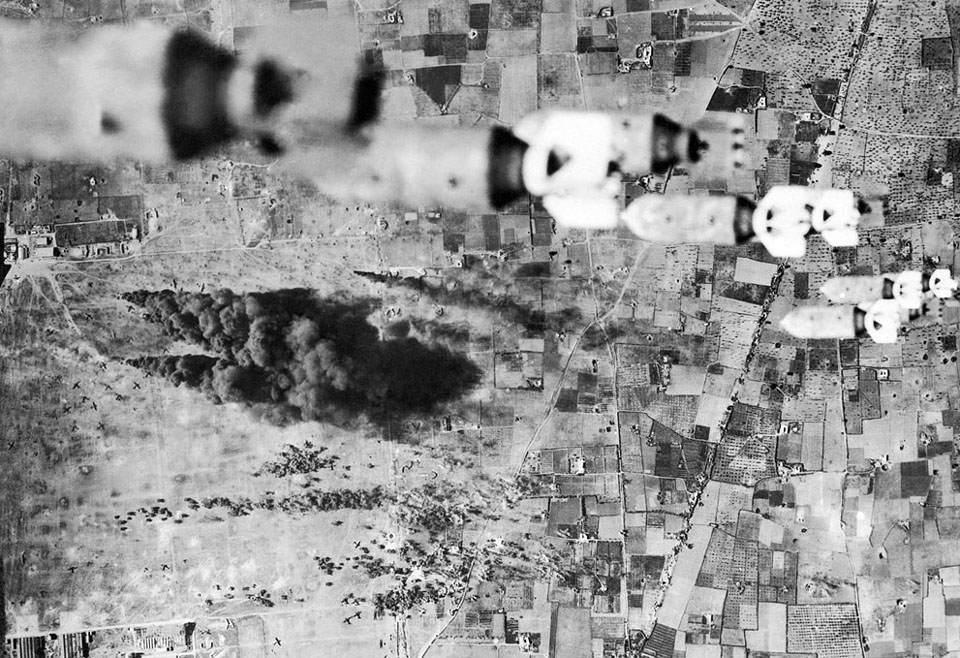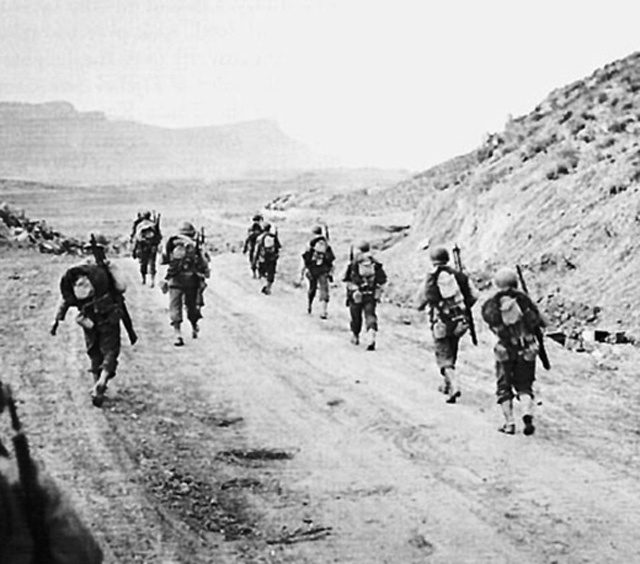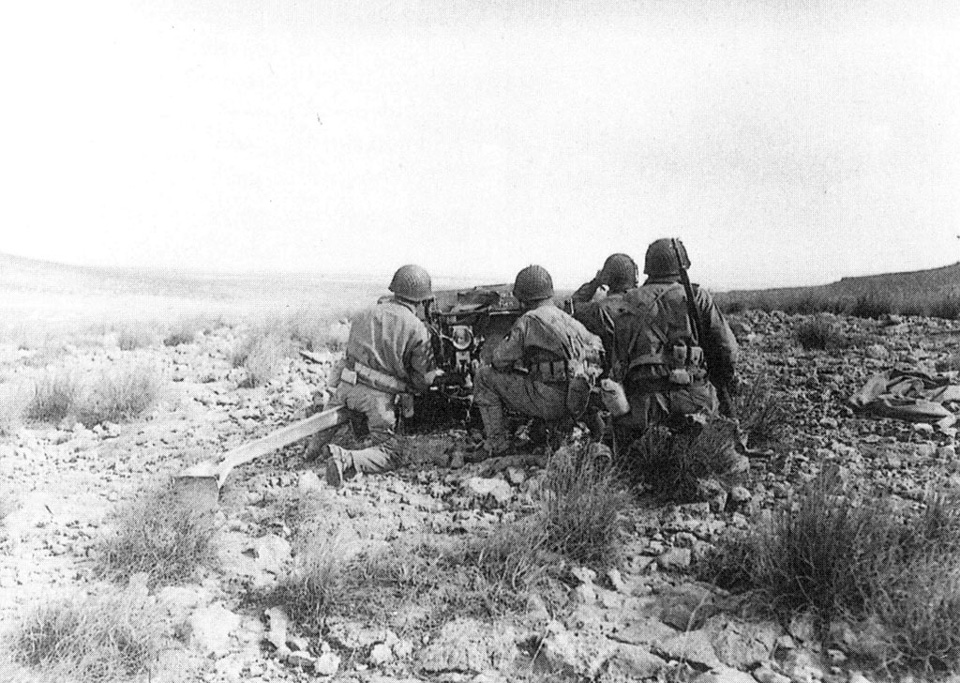Air Operations, Aleutians
7 A6M2-N 'Rufe' fighter-bombers attack the anchorage at Amchitka.
[Air Operations, Bismarcks
- 90th Heavy Bomb Group B-24s mount single-plane attacks against the sawmill at Ubili.
- During the night 32 43rd Heavy Bomb Group B-17s and 4 90th Heavy Bomb Group B-24s attack Rabaul, Kokopo, and ships at sea off Kokopo.
Air Operations, CBI
BURMA- 341st Medium Bomb Group B-25s attack the bridge at Myitnge.
- 14 51st Fighter Group P-40 fighter-bombers attack the town and barracks at Maingkwan.
Air Operations, Europe
BOMBER COMMANDDaylight Ops:
- 10 Mosquitos are sent to attack the Tours railway yards. 6 planes bomb successfully.
- There are no losses.
- 243 aircraft are sent to Colgone. Included in the total are 90 Halifaxes, 85 Wellingtons and 68 Stirlings.
- The Pathfinder marking is again based on skymarkers dropped by H2S. The marking is of only limited success. 218 planes claim to have hit the target area, but reports from the ground indicate that about 50 loads hit the city, mostly in the western districts. 2 industrial sites, 2 agricutural sites and 97 home are destroyed. 76 people are killed and 135 are injured.
- 3 Halifaxes, 3 Wellingtons and 3 Stirlings are lost.
- 142 Lancasters of Nos. 1, 5 and 8 Groups attack Milan.
- The bombing is concentrated in good visibiltiy. Fires can be seen from 100 miles away on the return flight. There are no reports from the ground as to the extent of the damage.
- 2 Lancasters are lost.
An unusual story is available, however, about a Lancaster of 101 Squadron, which was attacked by an Italian CR42 fighter just after bombing the target. The Lancaster was set on fire and the two gunners were both seriously injured, although they claimed to have shot down the fighter. The pilot, Sergeant IH Hazard, had to dive 8,000ft to put out the fire and 1 member of the crew mistook instructions and baled out. The remainder of the crew completed the extinguishing of the fire, tended the wounded and eventually reached England. The only officer in the crew, Pilot Officer FW Gates the wireless operator, was awarded the Distinguished Service Order and Sergeant Hazard and the other members of the crew who helped to bring the Lancaster home all received Conspicuous Gallantry Medals, an unusually high number of awards of this decoration. Sergeant Hazard died with his flight engineer and navigator when their Lancaster crashed in a flying accident in Yorkshire less than a month after the Milan incident, and Pilot Officer Gates died when the Lancaster in which he was flying, with another crew, crashed when returning from Dortmund on 5 May 1943; the two air gunners in the crew appear to have survived the war.Evening Ops:
- 4 Lancasters bomb La Spezia docks without a loss.
US Bombs Airfield at Tunis |
 |
Air Operations, New Guinea
- V Bomber Command B-25s attack the airfield at Lae.
- 90th Heavy Bomb Group B-24s mount single-plane attacks against Madang.
Air Operations, Solomons
- 9 VB-101 PB4Ys, escorted by 12 AirSoPac F4Us and 10 339th Fighter Squadron P-38s, are aggressively engaged by more than 50 Japanese Navy fighters while attacking the Kahili airfield on Bougainvillee. The Marine Corps escorts down 3 A6M Zeros, and 347th Fighter Group P-38s down 3 A6M Zeros over the Shortland Islands at 1148 hours. However, 2 PB4Ys, 2 F4Us, and 4 P-38s are lost.
- V Bomber Command heavy bombers attack Watom Island.
- Cactus Air Force bombers and fighters attack the Munda Point airfield on New Georgia, antiaircraft emplacements, and other targets in the Munda area, as well as a small ship near Kahili.
Air Operations, Tunisia
- 12th Air Force fighters strafe ground targets in a large area centered on Station de Sened and attack tanks and trucks near Sidi Saad.
- 12th Air Force A-20s bomb tanks in Faid Pass, the town of Maknassy, and the rail yard at Station de Sened.
Burma
The Chindits cross the Chindwin in 2 groups at Auktaung and Tonhe. Wingate is leading the larger northern group.
[Eastern Front
The Russians capture Rostov, the main outlet for the Germans retreating from the Caucasus, and the great industrial city of Voroshilovgrad and among other less important gains they take Drasny Sulin, north of Shakhty. Rostov has been a vital position for the Germans through which they have been able to evacuate part of Army Group A from the Caucasus. Army Group A has to withdraw to the Taman Peninsula between the Sea of Azov and the Black sea. The 1st Panzer is the only force to get through to the north before Rostov fell. The Red Army is now moving towards Stalino. The Germans undertake a re-grouping of their forces: the remains of the Don Army Group and Army Group B are combined to form- or actually to re-form- Army Group South under the command of von Manstein. The 2nd Army, or that part of it not cut off in the pocket northwest of Voronezh, is transferred to Army Group Center. Berlin admits the evacuation of Rostov and Voroshilovgrad according to plan.
SOUTHERN SECTORWith the Soviet 3rd Tank and 40th Armies south and southwest of Kharkov, the German Grossdeutschland, SS Das Reich, SS Leibstandarte, 168th and 320th Infantry Divs are in danger of being encircled. The 4th Panzer Army redeployes to the Dnepropetrovsk area as the Soviet 3rd Guards Army takes Voroshilovgrad and the 2nd Guards and 28th Armies retake Rostov.[MORE]
[North Africa
TUNISIAThe Battle of Kasserine Pass begins and will last for about 12 days. The Axis forces begin a major attack on the US II Corps positions west of Faid. The attacking troops are mostly from 10th and 21st Panzer Divs from Gen Jürgen von Arnim's 5th Panzer Army. Gen Heinz Ziegler is in direct command. This attack is only begun after considerable high-level debate. Rommel is still holding command of what is now known as 1st Italian Army and he and von Arnim have both produced plans of attack. Rommel urges an aggressive attack toward Tebessa but von Arnim's more limited plan is the one adopted at this stage. Gen Kenneth Anderson, commanding the Allied army, has at his disposal the British V Corps in the north, the French XIX Corps in the center and the American II Corps in the south. Rommel launches a surprise counter-offensive called Operation FRÜHLINGSWIND (SPRING WIND). Panzers supported by Stukas throw the inexperienced Americans into confusion. The Germans reach Kasserine Pass by 20 February, but are soon forced back. In the attack the inexperienced American forces around Sidi Bou Zid are given a vicious lesson.
|
|
In the British 1st Army's US II Corps area, the enemy begins a strong westward push at dawn with tanks and infantry supported by artillery and dive bombers. Combat Command A, 1st Armored Div, is forced to fall back toward Sbeïtla from positions east of Sidi Bou Zid. Elements of Combat Command A and the attached 168th Infantry are isolated on Djebel Lessouda, northeast of Sidi Bou Zid, and on Djebel Ksaïra and Garet Hadid in a region southeast of Sidi Bou Zid. To assist Combat Command A, which has suffered heavy tank losses, Combat Command C, reinforced by the 2nd Battalion of the 1st Armored Regiment of Combat Command B, is released from corps reserve for a counterattack on Sidi Bou Zid on the 15th. Because of the loss of Sidi Bou Zid on the northern flank of the corps, French and US forces, which include the 3rd Battalion of the 26th Regimental Combat Team, 1st Div, and the 1st Ranger Battalion, withdraw from Gafsa to Fériana during the night.
[Pacific
- The US submarine Amberjack (SS-219) is probably sunk by Japanese naval aircraft, the torpedo boat Hiyodori and the submarine chaser CH-18 off Cape St George, New Britain.
- The US submarine Trout (SS-202) sinks the Japanese gunboat Hirotama Maru (1911t) at the south entrance to Makassar Strait.

